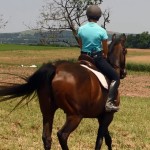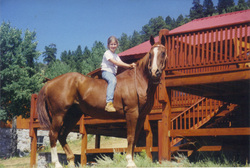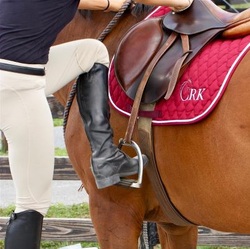I’ve got a new video for you today but I will keep the description short as we are in the middle of “Adult Camp” here at my farm! I did want to take a moment and thank you for all the awesome comments on the last post about “heels down.” Our community is growing to include so many awesome people who have great comments, ideas, and input – adding so much value to the subjects we discuss here. Thank you!
Steering is a fundamental part of riding and I have heard the mechanics of turning a horse explained many different ways – today I would like to keep it simple and share just three strategies that I find fundamental to steering in a way that maintains balance, allows for consistent cues, and helps a rider stay stable and in control when necessary.
Hit play to watch the video, then I will see you in the comments!
Callie














41 Responses
Good information! Unfortunately, I totally know what you mean about circles that look like hexagons! I typically ride gaited horses and they are ridden just a little bit differently; however, I think what you shared here applies to gaited horses and balance on them as well. Correct?
Thanks so much for your information!
Another great video
Excellent video. Love it. Think the hips part…meaning outer thigh comes on saddle… is very helpful part of the whole. I’m trying to be nice and stable there to help my horse and I be more upright and straight and your video show it so well. Not too much twisting, movement and unbalancing of the horse and rider as if often demonstrated….just right. Harmony. Lovely riding and teaching as always.
I look forward to receiving your videos. Thank you so much Callie, you have such a nice way of teaching. Joanie (Central Victoria, Australia).
Hi Callie.
Love this video. Great advise as always.
Our 14h grade A pony is very forward and very sensitive in his mouth. Anything we can do to leave his mouth alone makes it so much more enjoyable for him and so much more comfortable for us.
When we crude with light to no contact he keeps his head down and is much more relaxed.
I’m definitely trying these exercises today
Thanks from Dublin
Hi Callie….. all I can say is Thank you! Ever since taking your training courses I have gained confidence, a much better seat and even better communication with my horse. Riding has become so much more enjoyable for both of us. Keep up the great work!
Astrid & Windstar
Thanks Astrid – so glad to have you here!
Thanks Callie! You make it all look so effortless. I often find myself falling forward with my upper body..have a very uphill horse & find myself looking at his head too much. I think I get you with most of it..the hip..the outer hip turns the horse then in the direction of travel rather than inner hip? thanks, Wil
Hi Wil,
Yes – I think the easiest way to think about it is to turn your hips as you would if you were on your own two feet walking. Your hips should follow your shouders. Sometimes, if the rider’s body comes forward, their shoulders may be pointing in the new direction, but their hips in the opposite direction.
Does this help clear things up?
Thanks Callie, great tips that I’ll try to apply during my next lesson. Same as Wil, I’d appreciate if you could explain the relationship between hip(s) movement and the turn direction. Having little experience, I am afraid I missed it in the video. Again, many thanks.
Dear Callie, thanks so much for your videos. I gain a lot from your charismatic approach and love the way your videos get me thinking about my riding.
I’m watching from my dining chair and had a go at turning my shoulders, as if making a turn with my horse, and could feel my opposite hip very obviously press into the chair, which would “push my horse over” as you said – great!
Many thanks from Hong Kong
Hi Polly,
Glad you enjoyed the video and thanks for watching all the way from Hong Kong!
Another great video and I liked that you keep it simple. I think I can remember those 3 points. A beautiful video and Bandit looks fantastic!! Thank you. Nancy
Thanks Nancy!
Very helpful video. Thank you.
Thanks for another great instructional video. I have a question related to general steering. My horse often does not stay in a straight line along the wall of the arena and falls in. She sometimes is almost sideways and I feel like to need to over correct her a lot. Is there something I should be doing to steer her better in these situations?
Hi Eileen,
Your horse needs to learn to respond to inside leg by moving her ribcage over (and body, but its easier if you think specifically of the ribcage). There is generally a sequence of learning to be able to do this consistently, and you as the rider also want to make sure you have the skill to use your leg consistently. With a new rider, I usually tell them to just keep the horse’s nose on the fence with the outside rein and be quick about catching any movement drifting inward. The sooner you feel the horse drifting in, the easier it is to correct. In fact, you want to start feeling the first weight shift before they even start moving their feet in.
For a more advanced rider, we work on keeping the horse straighter along the rail with an inside flexion and inside leg keeping the horse’s body out and straight. Here is how I usually teach it to the horse: flexing right and left (flexing involves the poll, bending involves the neck), moving the hindquarters right and left, shifting the ribcage right and left (basically a step or two of leg yield). You can do each step along a fenceline first, actually moving away from the fence (the way your horse wants to move) to feel the mechanics of it. I realize this may be a bit confusing if you can’t picture each step, so let me know if you need more clarification!
Again, love the way you explain things! I am sitting on a swivel chair and when I do it right, the chair turns with me in the direction I am “traveling”. If I twist my body and push with the wrong hip, nothing happens. I believe this is a good simulation of what would happen on the horse.
Hey greetings from Greece i just saw your blog and your amazing youtube channel . I really love horses unfortunatelly i can’t own one because they are very expensive . I’ve seen so many people when riding horses to hurt them with a stick i really hate that . Horses are amazing and majestic animals .So i have this question . When you are riding a horse how you can accelerate without falling ??? . I always had that issue, so when i am riding a horse i almost always ride on very slow speeds
Best Wishes
Alexandridis Konstantinos
Hi Alexandridis! Riding is all about learning how to follow the horse’s movements with your body, and specifically your hips. As riders, we basically learn to balance on our sit bones.
Thanks sp much for replying !! 😉 😉 .This is so awesome i can finally learn all the things i want about horses . Cool !!! 😉 😉
Hi Callie,
I loved your video on steering. I always seem to forget about using my shoulders, head and looking where I want to go. It’s the same when I’m riding my motorcycle, my bike will go where I am looking (which can be a bad thing sometime). I love watching your videos, so informative. Thank you!! Barb
Hi Callie,
I found your training videos by accident a few weeks ago and wanted to let you know that they are helping this 59 year old beginner tremendously. Today I watched “How to steer your horse” and had an
“Ah-ha!” moment. My new Azteca mare is green (90 days under saddle) and I still have trouble steering her, which makes me nervous as I feel she’s in control and not me. I’ll be pulling on the left rein to go left, but she will send her hips and body to the right! I have a very bad habit of leaning forward, and so while watching your video it dawned on me that I’m causing my hips to send the opposite cue!! She’s a super sensitive and soft horse so I’m going to be super aware of those 3 pointers you gave us to focus on. Thanks again – you saved me, and my mare, from much frustration in our communication with each other.
Maggie and Via in Illinois
So glad the video helped you Maggie!
I have just started to ride which is the most relaxing and enjoyable activity I have ever done next to fly fishing. Over the past two months I been looking at any and all videos I can find on the net and you are the best I have found particularly for a true beginer. This month I started lessons and the first my instructor said was my seat in the sale looked good, well, thats because of you explaining it so very well. Keep teaching us!! I love riding and I have the best teacher to help me learn to enjoy this sport.
Thank you, Grant – I am glad you are enjoying the videos!
I fully agree with you Callie. I have experienced it myself on one particular horse. Keeping the reins a little loose, I just turned my head to the right and the horse turned right almost immediately. But sometimes when you do not want to do a full turn but only push your horse towards for example the outside track, then one has to use the leg and perhaps a little bit of rein.
Of all the instructions I’ve received about turning a circle, this is the best and most useful explanation ever. Makes perfect sense too. Thank you.
I agree!
This video was great with the physical demonstration by you! I teach a young rider on my horse and she is having difficulty with 2 things: being soft w/out collapsing inward and learning that her reins are not the be all and end all of “steering”. I now have another way now to demo to her the impact of using her body in a deliberate manner instead of a reactive manner. Like Maggie, my student gets the opposite reaction than she expects when she unintentionally steers with her hips.
I am probably very guilt of both leaning forward and looking down instead of farther out where I want to go. I will remember this as Wildfire and I have been trying to turn our hexagons into circles! Great info and presentation as always.
Thanks Shanna, glad you enjoyed it!
Callie: When I was a teenager growing up in war time England, I had the opportunity to sit on the back of a horse just once.
I have never forgot the thrill of that moment .
I now live on Vancouver Island, I am now retired and taking riding lesson, (at 81 yrs) I have been riding for the past couple years. I have lost count of the number of times I have watched your videos. I only ride once per week,I study your videos daily, they are a great help.
Cheers Frank.
Callie,
Thank you for your videos! They help me tremendously, especially after my lessons with my trainer, sort of a “review” session for me. I have just one question, how does this translate to your seat bones? In other words, when turning to the left, would I have more weight in my right seat bone? And would my left thigh be on and my right thigh softer? Something so simple as a turn has been a major struggle for my mare and I, and it is extremely evident in the canter. I know I have relied too much on hands for too long as a rider and now I have a horse that really responds to seat aids, I just need to catch up to her! Thank you for sharing your knowledge and time!
Hi Jan, I honestly think less about changing the weight on each seat bone and more on just shifting the direction of the pelvis. So as I want a right turn for example, my body and pelvis will rotate slightly right. Think of how your body turns as you walk a circle on your own two feet. In the saddle it really shouldn’t be much different. I find that too much emphasis on weighting one seat bone or especially trying to use the legs can actually inhibit the turn more than help it.
Thank you for this clarification!
Hi Callie, great video thank you, i am learning to ride on an ex racer and am quite small at 4″8 i find it hard to hold the reins down and at the right place. I always end up leaning forward to compensate for my lack of reach, would you have any tips to help me with steering, thank you
Hi Carol, thanks for your question! Instead of focusing on trying to get your hands into the “right” spot, carry your arms and hands where they are comfortable for your body because this is where they will be most effective. Upper arm hanging next to body and elbow bent to lift the lower arm, the elbow should remain soft and the angle of the elbow changes to maintain a straight line from bit to elbow.
Hi Callie,
I’m a brand new horse rider at the age of 55. I’ve been trail riding a bit with my son’s girlfriend and her mother (they have 3 horses) and have just taken my first lesson. I came home, started to google, and ran across your videos. I love them. You do such a great job of explaining things and you make it short and to the point so the videos are really easy to watch. I’m looking forward to my next lesson so I can try out the things you are saying.
Thanks Valerie
Thanks Callie, great video. I have always been taught to alien my shoulders with the horse’s shoulders but alien my hips the opposite direction . I have struggled with this concept for years. I want to make sure that I’m understanding what you’re explaining in this video. Are you saying that your hips and shoulders both should be matching your horse’s shoulders?
Merry, the basic concept of steering is that the turning actually comes from our center. If you think about starting the turn from your belly button you’ll notice that the rest of your body follows along with the movement. Practice this on the ground and you’ll find that you do it the same way when you are just walking!
-Julia Burdy, CRK Training Community Manager